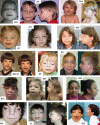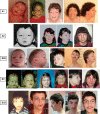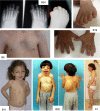Baraitser-Winter cerebrofrontofacial syndrome: delineation of the spectrum in 42 cases
- PMID: 25052316
- PMCID: PMC4326722
- DOI: 10.1038/ejhg.2014.95
Baraitser-Winter cerebrofrontofacial syndrome: delineation of the spectrum in 42 cases
Abstract
Baraitser-Winter, Fryns-Aftimos and cerebrofrontofacial syndrome types 1 and 3 have recently been associated with heterozygous gain-of-function mutations in one of the two ubiquitous cytoplasmic actin-encoding genes ACTB and ACTG1 that encode β- and γ-actins. We present detailed phenotypic descriptions and neuroimaging on 36 patients analyzed by our group and six cases from the literature with a molecularly proven actinopathy (9 ACTG1 and 33 ACTB). The major clinical anomalies are striking dysmorphic facial features with hypertelorism, broad nose with large tip and prominent root, congenital non-myopathic ptosis, ridged metopic suture and arched eyebrows. Iris or retinal coloboma is present in many cases, as is sensorineural deafness. Cleft lip and palate, hallux duplex, congenital heart defects and renal tract anomalies are seen in some cases. Microcephaly may develop with time. Nearly all patients with ACTG1 mutations, and around 60% of those with ACTB mutations have some degree of pachygyria with anteroposterior severity gradient, rarely lissencephaly or neuronal heterotopia. Reduction of shoulder girdle muscle bulk and progressive joint stiffness is common. Early muscular involvement, occasionally with congenital arthrogryposis, may be present. Progressive, severe dystonia was seen in one family. Intellectual disability and epilepsy are variable in severity and largely correlate with CNS anomalies. One patient developed acute lymphocytic leukemia, and another a cutaneous lymphoma, indicating that actinopathies may be cancer-predisposing disorders. Considering the multifaceted role of actins in cell physiology, we hypothesize that some clinical manifestations may be partially mutation specific. Baraitser-Winter cerebrofrontofacial syndrome is our suggested designation for this clinical entity.
Figures





Similar articles
-
Update on the ACTG1-associated Baraitser-Winter cerebrofrontofacial syndrome.Am J Med Genet A. 2016 Oct;170(10):2644-51. doi: 10.1002/ajmg.a.37771. Epub 2016 May 30. Am J Med Genet A. 2016. PMID: 27240540
-
Acute myeloid leukemia in Baraitser-Winter cerebrofrontofacial syndrome.Am J Med Genet A. 2017 Feb;173(2):546-549. doi: 10.1002/ajmg.a.38057. Epub 2016 Nov 21. Am J Med Genet A. 2017. PMID: 27868373
-
Baraitser-Winter cerebrofrontofacial syndrome.Clin Genet. 2017 Jul;92(1):3-9. doi: 10.1111/cge.12864. Epub 2016 Nov 30. Clin Genet. 2017. PMID: 27625340 Review.
-
A novel mutation in ACTG1 causing Baraitser-Winter syndrome with extremely variable expressivity in three generations.Ophthalmic Genet. 2017 Mar-Apr;38(2):152-156. doi: 10.3109/13816810.2016.1164196. Epub 2016 Apr 20. Ophthalmic Genet. 2017. PMID: 27096712 Free PMC article.
-
Coloboma may be a shared feature in a spectrum of disorders caused by mutations in the WDR37-PACS1-PACS2 axis.Am J Med Genet A. 2021 Mar;185(3):884-888. doi: 10.1002/ajmg.a.62020. Epub 2020 Dec 27. Am J Med Genet A. 2021. PMID: 33369122 Review.
Cited by
-
When Actin is Not Actin' Like It Should: A New Category of Distinct Primary Immunodeficiency Disorders.J Innate Immun. 2021;13(1):3-25. doi: 10.1159/000509717. Epub 2020 Aug 26. J Innate Immun. 2021. PMID: 32846417 Free PMC article. Review.
-
Multilineage ACTB mutation in a patient with fibro-osseous maxillary lesion and pilocytic astrocytoma.Am J Med Genet A. 2018 Sep;176(9):2037-2040. doi: 10.1002/ajmg.a.40475. Epub 2018 Aug 27. Am J Med Genet A. 2018. PMID: 30152002 Free PMC article. No abstract available.
-
Post-zygotic ACTB mutations underlie congenital smooth muscle hamartomas.J Cutan Pathol. 2020 Aug;47(8):681-685. doi: 10.1111/cup.13683. Epub 2020 Apr 6. J Cutan Pathol. 2020. PMID: 32170967 Free PMC article.
-
Landscape of mSWI/SNF chromatin remodeling complex perturbations in neurodevelopmental disorders.Nat Genet. 2023 Aug;55(8):1400-1412. doi: 10.1038/s41588-023-01451-6. Epub 2023 Jul 27. Nat Genet. 2023. PMID: 37500730 Free PMC article.
-
Obsessive-compulsive symptoms in ACTG1-associated Baraitser-Winter cerebrofrontofacial syndrome.J Neural Transm (Vienna). 2022 Nov;129(11):1387-1391. doi: 10.1007/s00702-022-02544-y. Epub 2022 Oct 7. J Neural Transm (Vienna). 2022. PMID: 36205783 Free PMC article.
References
-
- Ramer JC, Mascari MJ, Manders E, Ladda RL. Syndrome identification # 149: trigonocephaly, pachygyria, retinal coloboma and cardiac defect: a distinct syndrome. Dysmorph Clin Genet. 1992;6:15–20.
-
- Ramer JC, Lin AE, Dobyns WD, et al. Previously apparently undescribed syndrome: shallow orbits, ptosis, coloboma, trigonocephaly, gyral malformations, and mental and growth retardation. Am J Med Genet. 1995;57:403–409. - PubMed
-
- Winter RM. Cerebro-fronto-facial syndrome: three types. Clin Dysmorphol. 2001;10:79–80. - PubMed
Publication types
MeSH terms
Substances
Supplementary concepts
LinkOut - more resources
Full Text Sources
Other Literature Sources
Medical
Molecular Biology Databases
Miscellaneous

